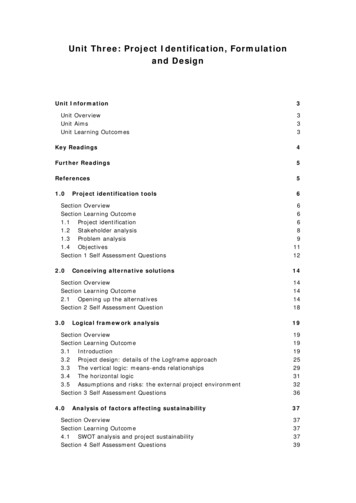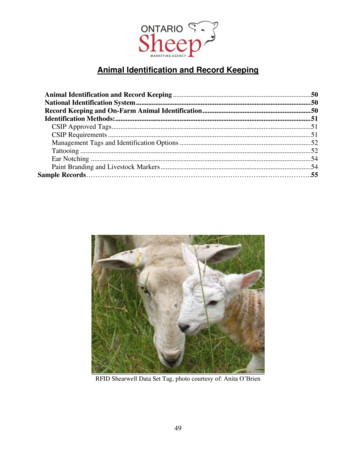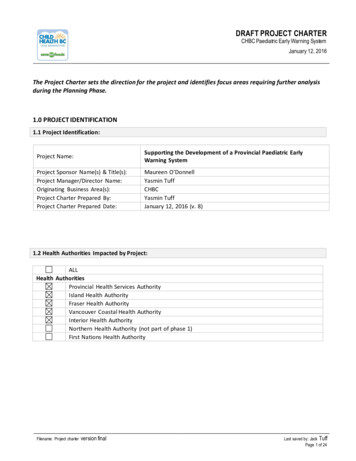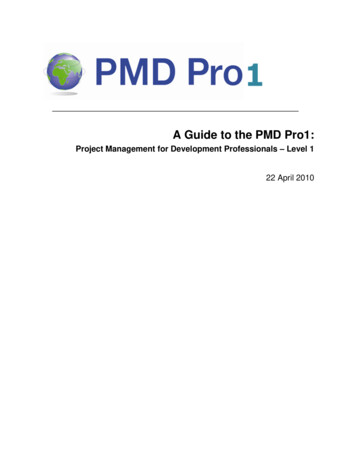
Transcription
Unit Three: Project Identification, Formulationand DesignUnit InformationUnit OverviewUnit AimsUnit Learning Outcomes3333Key Readings4Further Readings5References51.0Project identification tools6Section OverviewSection Learning Outcome1.1 Project identification1.2 Stakeholder analysis1.3 Problem analysis1.4 ObjectivesSection 1 Self Assessment Questions6668911122.0Conceiving alternative solutionsSection OverviewSection Learning Outcome2.1 Opening up the alternativesSection 2 Self Assessment Question3.0Logical framework analysisSection OverviewSection Learning Outcome3.1 Introduction3.2 Project design: details of the Logframe approach3.3 The vertical logic: means-ends relationships3.4 The horizontal logic3.5 Assumptions and risks: the external project environmentSection 3 Self Assessment Questions4.0Analysis of factors affecting sustainabilitySection OverviewSection Learning Outcome4.1 SWOT analysis and project sustainabilitySection 4 Self Assessment Questions14141414181919191925293132363737373739
P5345.0Project Planning and ManagementImplementation planning – work plansSection OverviewSection Learning Outcome5.1 Preparing work plansSection 5 Self Assessment QuestionsUnit 34040404044Unit Summary45Unit Self Assessment Questions46Key Terms and Concepts50 SOASCeDEP2
P534Project Planning and ManagementUnit 3UNIT INFORMATIONUnit OverviewThis unit focuses upon the identification, formulation, and design stages of theproject cycle. It provides guidance regarding setting project objectives and reviewingalternative approaches to solve a given development problem. It emphasises theinvolvement of stakeholders from the outset of project identification. A logicalframework (‘Logframe’) is introduced as a tool for project formulation, appraisal andmanagement. Other tools are introduced for assessment of sustainability and forplanning implementation.Unit Aims To provide background information and tools to guide project identification andformulation. To emphasise the importance of sound selection of alternative means at theearly stages of the cycle. To explain how sound choice can be guided by using tools such as Logframeanalysis. To demonstrate how project elements can be clearly specified and risksassessed and reduced. To set out how to link logical project design to work planning and budgeting.Unit Learning OutcomesBy the end of this unit, students should be able to: grasp the main issues and questions in project identification, formulation, anddesign understand the processes to follow in formulating projects to identify problemsfor primary stakeholders and set appropriate project objectives ensure that both alternative approaches and alternative means ofimplementation are fully considered and appropriate choices made in selectingthe best means of achieving given objectives know how to formulate logically consistent projects and to specify the keyproject elements in a clear and precise way identify, assess, and reduce project risks translate a project design in to implementation tools, particularly work plansUnit InterdependenciesThis unit makes use of concepts and terms introduced in Unit 2. In turn it introducesthe concepts of Logframe analysis which are also used in Unit 10. Otherwise, this unitcan be studied largely independently of the rest of the module. SOASCeDEP3
P534Project Planning and ManagementUnit 3KEY READINGS Belli P, Anderson JR, Barnum HN, Dixon JA, Tan J (2001) An overview ofeconomic analysis. In: Economic Analysis of Investment Operations: AnalyticalTools and Practical Applications. The World Bank, Washington DC, pp. 1–7.This short chapter provides an overview of project analysis and considers some of the questionsthat need to be answered during project identification, including questions relating tosustainability, who benefits, and the importance of considering alternatives. It is of relevanceto the whole of this unit. Dearden P, Kowalski B (2003) Programme and project cycle management(PPCM): lessons from south and north. Development in Practice 13(5) 501–514.This provides a critique of logical frameworks and highlights the importance of thinking beyondthe framework. It stresses the importance of a broader knowledge of programme and projectcycle management by stakeholders involved. It also emphasises the value of treating theLogframe as a ‘living document’. DFID (2003) Logical frameworks. In: Tools for Development: a Handbook forthose Engaged in Development Activity. UK Department for InternationalDevelopment (DFID), pp. 5.1–5.9.Available es/publications/tools for development- a handbook for those engaged in development activities.pdfThis provides more detail about how to develop Logframes, their advantages and limitations. Itoutlines key steps in developing a Logframe including the key components of goal, purpose,outputs and activities, how to define indicators and analysing risks and assumptions. Potts D (2002) Project identification and formulation. In: Potts D Project Planningand Analysis for Development. Lynne Reinner Publishers, London. pp. 23–46.This chapter provides further background into project identification, formulation, andscreening. It also succinctly explains with examples the tools described in this section —stakeholder analysis, objectives analysis, alternatives analysis, and the project framework, andit presents a useful diagram of a problem tree. SOASCeDEP4
P534Project Planning and ManagementUnit 3FURTHER READINGSDFID (2003) Stakeholder analysis. In: Tools for Development: a Handbook for thoseEngaged in Development Activity. UK Department for International Development(DFID), pp. 2.1–2.11.DFID (2003) Problem and situational analysis. In: Tools for Development: aHandbook for those Engaged in Development Activity. UK Department forInternational Development (DFID), pp. 3.1–3.9.Available es/publications/tools for development- a handbook for those engaged in development activities.pdfWorld Bank (2005) The Logframe Handbook: a Logical Framework Approach toProject Cycle Management. The World Bank, Washington DC.Available from: http://wwwwds.worldbank.org/servlet/main?print Y&menuPK 64187510&pagePK 64193027&piPK 64187937&theSitePK 523679&entityID 000160016 20050607122225REFERENCESDFID (2003) Logical frameworks. In: Tools for Development: a Handbook for thoseEngaged in Development Activity. UK Department for International Development(DFID), pp. 5.1–5.9.World Bank (2005) The Logframe Handbook: a Logical Framework Approach toProject Cycle Management. The World Bank, Washington DC. SOASCeDEP5
P534Project Planning and ManagementUnit 31.0 PROJECT IDENTIFICATION TOOLSSection OverviewThis section introduces project identification and the importance of settingappropriate objectives. It provides guidance and tools concerning stakeholderanalysis, problem analysis, and objectives setting.Section Learning OutcomeBy the end of this section, students should be able to: know the processes to follow in formulating projects to identify problems forprimary stakeholders and set appropriate project objectives1.1Project identificationThe five major stages of the project cycle are identification, preparation,appraisal, implementation and evaluation. The first two stages are largely theresponsibility of government, which may intend to finance a project from its ownresources or to seek external assistance, though donor agencies may play aninfluential role.Viewed as a technical process identification involves, in the following sequence Preliminary stakeholder analysis Problem analysis Setting of objectives Analysis of alternatives Accountability analysis Logical framework thinking Analysis of assumptions and associated risks Progress indicator definition Stakeholder reviewIt can be powerfully argued that this is the most critical stage of the cycle. If thepotential of the most viable concepts are overlooked at identification there is littleprospect that they will be retrieved at a later stage, when the emphasis shifts fromexamining options to filling in the details of a specific proposal. It can be costly anddifficult to abort or radically revise the preparation of a project once underway.Economists often think in terms of resources, opportunities, and constraints, andthis provides an analytical framework with which to generate project ideas. 1.1.1,below, illustrates this and the wide range of possible sources for project concepts. SOASCeDEP6
P534Project Planning and ManagementUnit 31.1.1 Project identificationIn practice, project ideas often result from the identification of–a discrete set of activities identified as important within programme-basedactivities, a country’s poverty reduction strategy and/or sector-wide approach–problems or constraints in the development process caused by shortages of essentialfacilities, services, and material or human resources and by institutional or otherobstacles–unused or underused material or human resources and opportunities for theirconversion to more productive purposes; or, conversely, overused natural resourcesthat need to be conserved or restored–unsatisfied demands or needs and possible means to meet them includingopportunities arising from new technology or technological development, forexample, the internet and mobile telephony–the need to complement other investments (such as providing railway and port linksfor a mining project, transport, packing and marketing facilities for an agriculturaldevelopment project, or access roads for a sugar factory and bio-ethanol plant)Project ideas may also emanate from–initiatives by local private or public entrepreneurs who wish to take advantage ofopportunities they perceive or who are responding to government incentives–community initiatives (often supported by national or international NGOs)–a government response to local political or social pressures originating, for example,from economic, social, or regional inequalities–a need for advocacy aimed at government in a weak policy environment–the pursuit of national objectives such as food security–the occurrence of natural events (drought, floods, earthquakes) and the short-termresponses to crisis–as a response to long-term trends such as migration, environmental degradation, andclimate change–a desire to create a permanent local capability to carry out development activitiesby building up local institutionsFinally, project ideas originate not only from within a country but also from abroad as aresult of–investment proposals of multinational firms–programming activities of bilateral and multilateral aid agencies and their ongoingprojects in the country–influence of investment strategies adopted by other developing countries as well asopportunities created by international agreements (for example, on the use ofoffshore resources)–prevailing professional opinion or public consensus within the internationalcommunity in such fields as population, environment, and the alleviation of povertySource: unit authorIt should also be noted that the idea of project identification as transparent, purelytechnocratic and objective does not always hold true. Project identification can behighly political, involving powerful groups which conflict and bargain in their attemptsto manipulate the agenda for public action. SOASCeDEP7
P5341.2Project Planning and ManagementUnit 3Stakeholder analysisAs a first stage it is important to carry out a preliminary stakeholder analysis. Thisenables identification of the primary stakeholders, as well as partners and their roles.Greater understanding of interest groups and their interest should result in a betterquality project.Stakeholders are individuals, groups or organisations who have an interest or stakein a project. They may be direct or indirect interests, and positive or negative. Theirstake in the project may be in terms of their rights or duties or they may be affectedby the outcome.Different roles for stakeholders can be identified at this stage, and these can bedeveloped as the project progresses. Different organisations can play different rolessuch as sub-contractors, delivery agency, enabling agency etc. Furthermore, it is alsopossible to identify if any interest groups present threats to the success of theprojects, and plans can be put in place to respond to any such events.There is increasingly a focus on the identification of agriculture and ruraldevelopment initiatives using a ‘bottom-up’ learning approach which emphasises theimportance of primary stakeholders informed and participating in the identificationstage. For process projects which encourage learning from experience, and listeningto participants, engaging with stakeholders from the outset is particularly important.The outcome of the stakeholder analysis at this stage is that the primary stakeholderis identified before the objectives of the project are finalised. This ensures that theproblem analysis relates specifically to the primary stakeholders.Stakeholder tables are often constructed which provide a structured format forassessing the interest of each group.StakeholdergroupInterestPotential impactPotentialinfluencePossible rolePrimary Secondary ExternalStakeholder tables can be developed in different formats, for example, 1.2.1 showsthe different stakeholders, their interest in the project, and whether their interest ispositive or negative. SOASCeDEP8
P534Project Planning and ManagementUnit 31.2.1 Example stakeholder tableStakeholderInterest in projectSmall farmers Higher output and incomes Food traders More sales Labourers More jobs Moneylenders Empowered clients Less business Success of project Possible loss of rent if farmers Governmentofficials ve/ vebecome empoweredSource: DFID (2002) p. 2.3.1.2.2 Limitations of stakeholder analysisStakeholder analysis is an effective and commonly used tool, but its use does notguarantee success. There are a number of risks and practical problems that should beavoided in its use. These include:–that the jargon can be threatening to many–the analysis can only be as good as the information collected and used–use of matrices for analysis and presentation can oversimplify complex situations–the judgements used in placing stakeholders in a matrix or table are oftensubjective. Ideally, several opinions from different sources will be used to confirm ordeny the judgement–team working can be damaged if the differences between groups in an activity,rather than their common ground, are over-emphasised–trying to describe winners and losers, as well as predicting hidden conflicts andinterests, can alienate powerful groups–the analysis may lead to the re-emergence of conflicts that had lain dormantSource: DFID (2002) p. 2.4.1.3Problem analysisProjects aim to address a problem or constraint. It is vital to understand the causesof the problem or constraint, how they affect stakeholders, and how to focus ontackling them.A helpful tool for systematically understanding the causes of a problem is theproblem tree method. This involves the identification of a core problem (at thecentre) which is based on the best understanding and sources of informationavailable. It is important to reach agreement amongst the participants of the keycore problem. SOASCeDEP9
P534Project Planning and ManagementUnit 3The causes of the problem are then traced back as the ‘roots’ of the problem andprovide the causal chain.The effects of the problem are then traced forward as the branches and main effectsof a problem on stakeholders.Diagnosis is a crucial stage in project identification and there are many examples ofmistaken diagnosis in project design. Some commonly recognised examples are citedin 1.3.1. Can you add to this list?1.3.1 Typical examples of mistaken diagnosis in project design(1) Failure to understand the motivation of the intended beneficiaries, or the existenceof factors which would restrict their participation in, or response to, a project: egcredit to women farmers.(2) Failure to understand the limits to improvements in institutional performance.(3) Inadequate market analysis of demand and price forecasts for commodities for whichproduction is to be increased.(4) Non-recognition of the degree of dependence of a form of development on subsidieswhich a government may not be able to sustain or is committed to remove undermacroeconomic reforms.(5) Non-recognition of the unattractiveness to entrepreneurs of the services which agovernment seeks to privatise. Simply they are not profitable.(6) Proposals for provision of services by government agencies which could be suppliedmore efficiently and effectively by the private sector.(7) Failure to properly determine and understand the physical locations and causes ofwater losses within an irrigation scheme and also to take account of competing plansfor water use in urban areas.(8) Underestimation of the difficulty in the humid tropics of maintaining soil fertility andstructure, for sustainable annual cropping.(9) Incomprehension of the political and social factors which may militate againstdecentralisation or meaningful peoples’ participation in project design andexecution.(10)Poor assessment of the adequacy of essential infrastructure.Source: unit author Think about one of the following core problems in a development contextwith which you are familiar and develop a problem tree around it,tracing out the key causes and effects of one of these problems.(1) There is limited access to markets for produce(2) Drought has reduced crop yields this year(3) The nearest health clinic is 15 miles away by foot(4) One of the devastating results of HIV/AIDS has been reduced labourin the village SOASCeDEP10
P534Project Planning and Management1.4Unit 3ObjectivesWhen there is agreement and understanding about the core problem and the causesand effects, the project objectives can be specified.The project purpose is developed by restating the core problem in positive terms.The project goal is created by articulating the effects of the problem in positiveterms.Although setting project objectives appears to be straightforward, the process mayprovide insights which could require revisiting the core problem. Overall the approachmay need to be an iterative one. Initial consideration of objectives may promptfurther investigation and data collection, and/or consultation with stakeholders.Trade-offs must be assessed that arise between multiple and conflicting objectives.For example, the objective of raising production of cash crops for export may have tobe weighed against the objective of increasing domestic employment or of improvingequity. The objective of an agricultural sector project could be functional (to providea national service), regional (to develop a particular area), or subsectoral (to expandthe production of a crop) – but can probably not be all of these at once.Selection of a clear and simple objective, such as strengthening a nationalagricultural extension service, may enhance the prospects of success. It may also,however, limit the project’s overall contribution to development unless othercomplementary investments (such as in agricultural research or credit) are alsoundertaken.Section Summary This section has introduced you to project identification and the process tofollow in formulating projects. It has equipped you with tools for ascertaining who the primary and secondarystakeholders are (stakeholder analysis); the problem a project aims to address(problem analysis) and formulating key objectives. SOASCeDEP11
P534Project Planning and ManagementUnit 3Section 1 Self Assessment QuestionsQuestion 1True or false?(a) Project identification is not an important part of the project cycle.(b) Stakeholder analysis should be carried out when the project objective has beendecided.(c) Core problems should be agreed upon by the project team only.(d) Objectives can be set by considering the core problem in a positive light.Question 2Using the following Problem Tree and Objectives Analysis, fill in the blanks.(a) Problem tree analysisDefine the focal problem, its immediate and direct causes and effects(a)Increased demandon health servicesReduced productivityIncreased morbidityand mortalityOutbreak of cholerain Kingstown, StVincentPoor sanitaryconditionsOpen pitlatrinesContaminated watersupplyFlooding inurban areas(b)Poormaintenance ofwater mainsUnhygienic healthpractices and foodpreparationLack ofknowledgeLow levelsof incomeSource: DFID (2002) p. 3.4. SOASCeDEP12
P534Project Planning and ManagementUnit 3(b) Objectives tree analysisTransform each problem statement into an objectiveTourism restoredReduced demand onhealth servicesProductivity restoredDecreased morbidityand mortalityEliminate outbreakof cholera inKingstownSanitary conditionsimprovedPit latrinesimprovedSewermaintenanceimprovedPotable watersupplied in targetareasFlood controlmeasuresimplementedMaintenance ofwater mainsimproved(c)Healtheducation intargetcommunities(d)Source: DFID (2002) p. 3.5. SOASCeDEP13
P534Project Planning and ManagementUnit 32.0 CONCEIVING ALTERNATIVE SOLUTIONSSection OverviewIn this section we consider why it is vitally important to ‘open up the alternatives’before settling on a diagnosis of a development problem and a single concept anddesign for a project. This is a difficult issue, but some general approaches and toolsto use are suggested.Section Learning OutcomeBy the end of this section, students should be able to:thoroughly understand how to explore alternative strategies to meet the sameproject objective 2.1Opening up the alternativesExamination and refining of alternative strategies must not be neglected, thoughthere will always be pressures to move rapidly on to detailed project design andappraisal. These pressures may include political interference, the fixing of lendingprogramme targets, limitations in time and resources allocated to projectidentification and formulation, and professional bias (see 2.1.1). If the projectidentification team is pressurised into accepting what appears at first sight to be aviable proposal without looking much further, then subsequent preparation isreduced to simply making the best case for that proposal. Decisions made at thisstage can have far reaching consequences: some are likely to be irreversible nomatter how thorough the subsequent preparation and appraisal, while others maylargely determine the quality of the project and its impact on development. There isno substitute for being right in the first place.2.1.1 Professional bias in project identificationGiven a national development objective such as improved food security irrigationengineers may tend to see irrigation as the preferred way to attain that goal. Within theengineering profession there are sub-groups. Mechanical engineers will look to pumpoptions and civil engineers to dams and canals; agricultural engineers will stress fieldengineering and land levelling. On the other hand a national grain storage agency mayclaim that expansion of its own infrastructure is the only valid approach to achieving thesame goal. If the real problem is a lack of price incentives for cereal growers, thenneither agency’s proposed solution is conceptually valid. Such things need checking atthe identification stage.In project identification it is important to get to the real cause of the problem and notto produce a project that deals with symptoms. Consider the following light-hearted taleabout the medical profession.A man goes to the Doctor with a bad back. The Doctor admits her profession is not goodwith backs but suggests the patient stands in the rain for three hours each day. Thepatient catches severe influenza and returns to the Doctor, now with two ailments, butthe Doctor brightens because she knows how to treat influenza. She is now dealing withsomething she is good at handling.Professionals must not twist the problems of rural people to suit their professional anglesand skills.Source: unit author SOASCeDEP14
P534Project Planning and ManagementUnit 3Conceiving of alternative solutions is where project planners need to be at their mostcreative and imaginative, and where an inter-disciplinary approach and consultationwith the widest practicable constituency are the most important. ‘Open up thealternatives’, should be the byword of all project formulators.Very few problems have only one possible solution. There are no demonstrably ‘right’or ‘wrong’ answers in the design of agricultural and rural development projects: onlyvarying degrees of plausibility and risk. Too often in the past project concepts havebeen processed through appraisal without adequate consideration of alternative, andpossible cheaper or more effective, ways of achieving the same objectives. Whetherthe result of vested interest, of political pressure or simply lack of information onfeasible alternatives, the consequences are the same: opportunities lost or foregone,which can seldom be recaptured.The project identification and preparation process will initially involve choice betweenalternative forms of intervention or project strategy.For example: the objective of a project may be to strengthen the marketing systems for aspecified crop in a given region. This could be achieved through a projectdesigned to strengthen and stimulate private traders, or through public sectorintervention (eg a parastatal, or marketing board), or through promotion offarmer co-operatives. the objective of increasing output of a specific crop might be achieved throughimprovements in research, extension, input supply, access to credit, marketingfacilities and market information; or a combination of these. An alternativecrop might be a substitute.Remember that such choices are not necessarily mutually exclusive. Combinations ofmeasures may be most appropriate. In general back what works and repeat success.In opening up the alternatives it is useful to consider as many different routes aspossible, some will be discarded almost immediately, but others may introduce newideas and insights which may contribute positively to the final project design.The following process is suggested for this.(1) Listing as many likely alternatives as can be thought of.The range of options is likely to broaden if ideas are drawn together from awide range of sources. Chances for brainstorming within the project planningteam, with government agencies, non-governmental contacts and withintended beneficiaries should be cultivated.(2) Consideration of each alternative with a view to eliminating some andcombining others. At this stage consideration of each alternative willstrengthen the justification for and scope of the one which is eventuallyselected. For ranking options, precedent - local or foreign - is likely to be apowerful guide. Have similar solutions in the project area or analogous settingsworked in the past?–Is a pilot exercise or experimental work elsewhere giving promising results?–What are the most successful farmers doing?–Which initiativesunsustainable? SOAShavenotworked,CeDEPorhavebeenproventobe15
P534Project Planning and ManagementUnit 3(3) Selection of promising alternatives for preliminary formulation.The alternatives listed in step 1 may arise from an analysis of existingconstraints. The following example considers this in more detail.Take the project objective to be increased output of beef in a particular region.The present low levels of output may be the result of(a) cattle diseases or parasites, or a combination of both(b) low quality of the breeding stock(c) lack of water during the dry season(d) inadequate feeding (overall, seasonal, and/or a particular nutritional ormineral deficiency)(e) other unknown causeIf any of these constraints were removed, some increase in the output of meat wouldbe expected. If two or more constraints were removed simultaneously, then anotably greater increase in output might be obtained, although the projectintervention would be more costly, complex and difficult to manage.Alternatives may also be joint or complementary in terms of the approach required.Options (a) and (d) above are both susceptible to alleviation through extensionactivities and it may not be worth doing (a) without (d) or vice versa. In fact projectsto address (a), (b) and (d) will all require extension but (b) will also require abreeding programme. Once production has moved to a higher plane (a newproduction function) as a result of one intervention, other more costly projects maybecome economic propositions.The project designers must therefore consider in some detail the feasibility and costsassociated with overcoming each of these constraints, independently, in combinationor in sequence. Suppose that a widespread and regular programme of inoculation ofcattle would alleviate the first constraint (a). The overall cost of doing this, in termsof inputs and personnel must be estimated as well as the likely effectiveness andimpact on the output and quality of meat. Obviously the more widespread andregular the programme is, the higher the costs will be, and at each level these needto be set against the probable benefits. Careful examination of similar projectselsewhere and all relevant documentation, an awareness of the local environment,and reliable information as to the availability of vaccine and appropriately skilledtechnicians will all help the technical expert in this evaluation.It should be borne in mind that costs and benefits are unlikely to rise uniformly withthe scale of operations. The analyst has to ascertain as far as is possible therelationship between costs (resources, inputs, commitment of personnel) andbenefits (probable effect on output of meat) for different scales of projects designedto reduce or eradicate cattle disease. This is so as to be able to compare thisapproach with alternatives.An alternative project might be construction of boreholes (tubewells), which
Unit Three: Project Identification, Formulation and Design Unit Information 3 Unit Overview 3 Unit Aims 3 Unit Learning Outcomes 3 Key Readings 4 Further Readings 5 References 5 1.0 Project identification tools 6 Section Overview 6 Section Learning Outcome 6 1.1 Project identification 6 1.2 Stakeholder analysis 8 1.3 Problem analysis 9 1.4 Objectives 11










